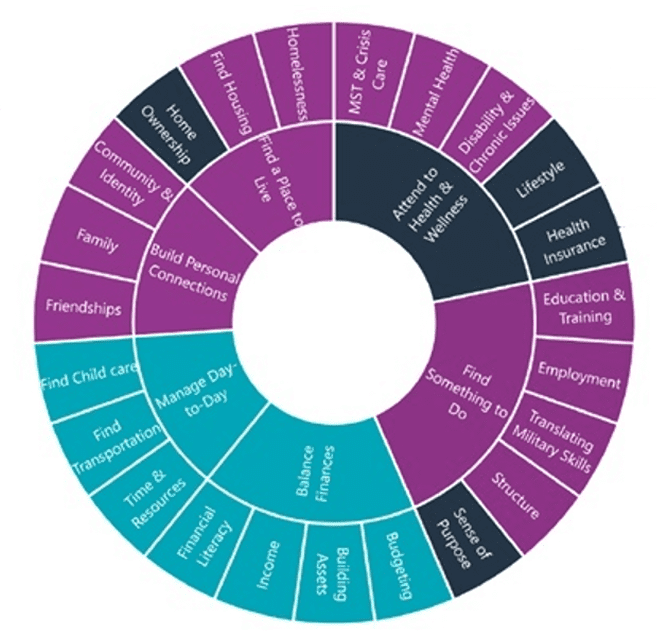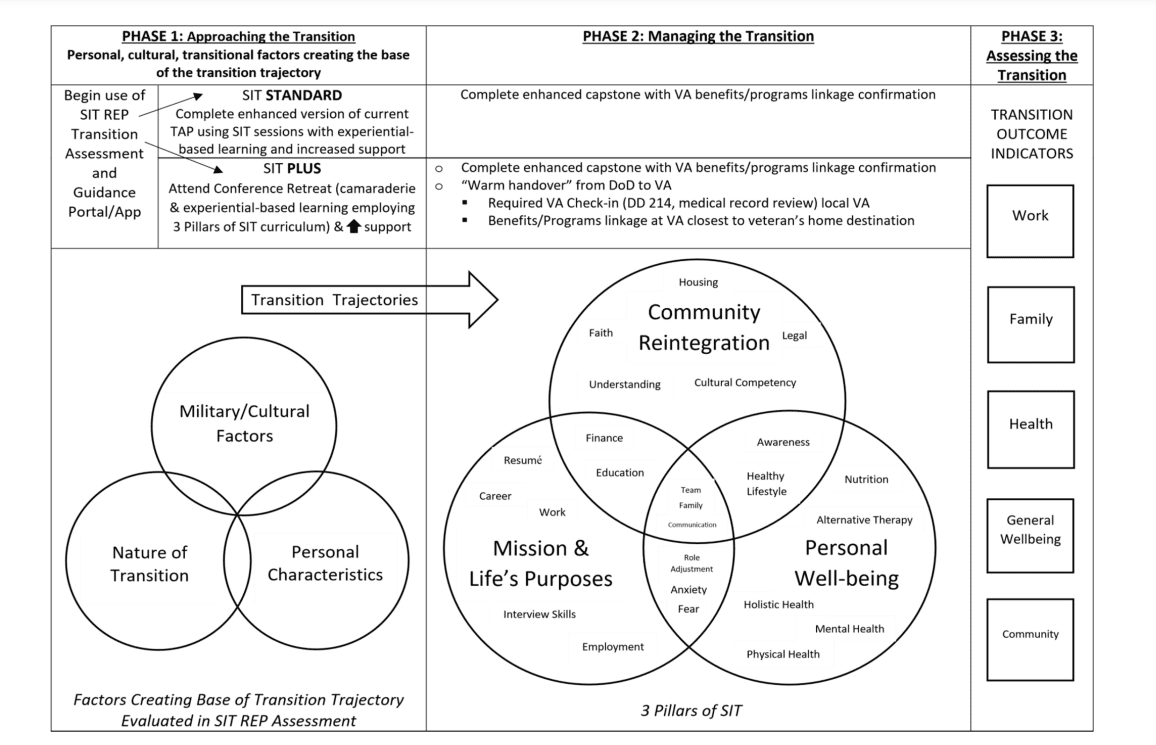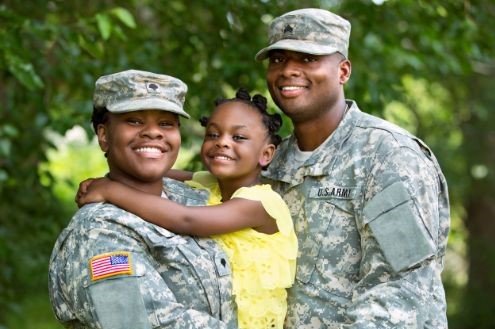By Jenny Rea, Ph.D.
While many separating service members successfully adapt to civilian life, 40 to 75% describe some difficulties managing this major transition (Castro & Kintzle, 2017; Zoli, Maury, & Fay, 2015). For instance, within the first year of transitioning to civilian life, Veterans face increased challenges with homelessness, family integration, employment, post-traumatic stress disorder (PTSD), and substance abuse, all of which can increase the risk for suicide (VA, 2018).
To better support service members and Veterans, the U.S. Departments of Veterans Affairs (VA), Defense (DoD), and Homeland Security (DHS) partnered to create the VA Solid Start (VASS) program to focus resources and action to reduce suicide rates among this population. Specifically, the purpose of the VASS program is to “engage and connect with Veterans during this critical period to provide support and assistance to help ensure a successful transition to civilian life.”
Our OneOp colleagues, Military Caregiving, hosted a webinar focusing on the VASS program; including its purpose, related resources and information about the program, and how service providers working with Veterans might use it as they support the transition to civilian life. When you have a moment, watch the webinar to learn more!

Figure 1. Pillars of Successful Transition adapted and utilized by the VASS program.
One of the key components that were addressed in the webinar was the “Pillars of Successful Transition.” This is the framework (Figure 1) upon which the VASS program is based, and what VASS representatives ask about as they talk with Veterans.
Research has shown that the pillars located within the inner circle are key for Veterans to attain a successful transition into civilian life. These include:
- Manage Day-to-Day
- Build Personal Connections
- Find a Place to Live
- Attend to Health and Wellness
- Find Something to Do
- Balance Finances
All the things that contribute to the success of each individual pillar are then located on the outer circle, such as finding employment, building assets, and creating a healthy lifestyle. For example, if a Veteran is experiencing challenges with mental health, the VASS representative will provide them with resources (e.g., referral to a trained mental health counselor) to help them attend to their health and wellness.
Similar to the VASS program mission, the Transition Assistance Program (TAP) “provides information, tools, and training to ensure service members and their spouses are prepared for the next step in civilian life.” In a recent study, Whitworth and colleagues (2020) describe how ‘The Success in Transition (SIT) Model (Figure 2)’ provides a guiding framework for reconceptualizing TAP.

Fig. 2. Whitworth, J., Smet, B., & Anderson, B. (2020). Reconceptualizing the U.S. military’s Transition Assistance Program: The Success in Transition Model. Journal of Veterans Studies, 6(1), pp. 25–35. DOI: https://doi.org/10.21061/jvs.v6i1.144 .
Although only three pillars are mentioned within the SIT Model, further detail based on research and theory has been provided to better assist service members (and Veterans) in transition into civilian life. Throughout Phase Two of the SIT Model, the service member is actively involved in transitioning into their new civilian setting. The three overlapping pillars are Community Reintegration, Mission and Life’s Purposes, and Personal Well-Being during the transition process.
Parallel to the Pillars of Successful Transition, the three pillars within the SIT Model represents the central areas of needs, challenges, and strengths involved in a successful military to civilian transition.
As part of the service member’s community reintegration, they will need to:
- Find appropriate housing,
- Develop cultural competence within their new setting and;
- Utilize their personal/communal faith resources and legal assistance as needed.
Transitioning members will identify a new non-military mission and life purpose, and this is often done, in part, by obtaining new employment and pursuing a career or by working toward an educational goal or degree.
Service members will plan for and address personal well-being needs through attending to physical and mental health, learning about the benefits of a healthy lifestyle, and nutrition, and practicing some alternative therapy approaches, for example.
To improve their overall transition in all three SIT pillars, service members will work on the three overlapping areas of developing a supportive team and family while also fostering clear and open communication throughout the process. It will also be important for the service member to address fears and anxieties in their role adjustment of all three pillars so that they can improve the potential for successfully adapting to the transition.
The SIT Model Applied
There are a number of components that assure service members are fully linked-up and connected to services and programs available to support them. As the SIT Model indicates, during Phase Two, service members will:
- Participate in the SIT Standard Program – Veterans will specify how they met career readiness standards as well as outline their transition plan, incorporating VA benefits and other programs they have accessed or plan to utilize. All will be completed through the SITREP (Situation Report) tool.
- Complete a formally documented VA check-in (The “Warm Handover”) – Veterans will select a VA personnel to review their DD214 and medical records. The representative will ensure that the Veteran has linked up with benefits and programs at the VA closest to their home destination.
- Meet with a representative of the VA and/or Vet Center for final check-in – The Veteran’s needs assessment from Phase One of the SITREP Process and its updated version during Phase Two will be reviewed. Job/career and educational resources available in the Veteran’s local community will also be addressed. Further, the representative will provide a tour and explain what resources the local VA or Vet Center has to offer the Veteran and their family.
- Enroll into the VA system with an explanation for how to do so by the representative.
As you work with service members, Veterans, and their families, consider incorporating the pillars mentioned above. Although each framework (Pillars of Successful Transition and The SIT Model) was designed specifically to meet the needs of service members and Veterans during the transition from military to civilian life, it is likely that these components can be applied to various points or outcomes (e.g., general well-being, health) within a service member and their families lives. In order to better support this population and ensure they have the ability to adapt to various transitions successfully, it will likely involve planning ahead and preparation. As Benjamin Franklin once said, “If you fail to plan, you are planning to fail.”
Additional Resources
-
- Separation/Transition resources and programs through MIlitary OneSource
- Veterans Crisis Line 1-800-273-8255 – Press 1
References
Castro, C. A., & Kintzle, S. (2017). The state of the American military veteran: The San Francisco veterans study. Retrieved from http://cir.usc.edu/wp-content/uploads/2017/05/USC-CIR-SF-VET-2017_FINAL-Pgs.pdf
VA (2018). National Strategy for Preventing Veteran Suicide, 2018-2028. Department of Veterans Affairs, Office of Mental Health and Suicide Prevention. June 2018.
Whitworth, J., Smet, B., & Anderson, B. (2020). Reconceptualizing the U.S. military’s Transition Assistance Program: The Success in Transition Model. Journal of Veterans Studies, 6(1), pp. 25–35. DOI: https://doi.org/10.21061/jvs.v6i1.144
Zoli, C., Maury, R., & Fay, D. (2015). Missing perspectives: Service members’ transition from service to civilian life—data-driven research to enact the promise of the Post-9/11 GI Bill. Institute for Veterans & Military Families, Syracuse University. Retrieved from https://surface.syr.edu/cgi/viewcontent.cgi?referer=&httpsredir=1&article=1006&context=ivmf
 Jenny Rea, Ph.D., is a military spouse and mom of four kiddos under six years. Jenny consults with OneOp and is an Assistant Professor of Practice in the Department of Human Services and Director of the Certificate in Military Families at the University of Arizona.
Jenny Rea, Ph.D., is a military spouse and mom of four kiddos under six years. Jenny consults with OneOp and is an Assistant Professor of Practice in the Department of Human Services and Director of the Certificate in Military Families at the University of Arizona.
Photo source: Canva















